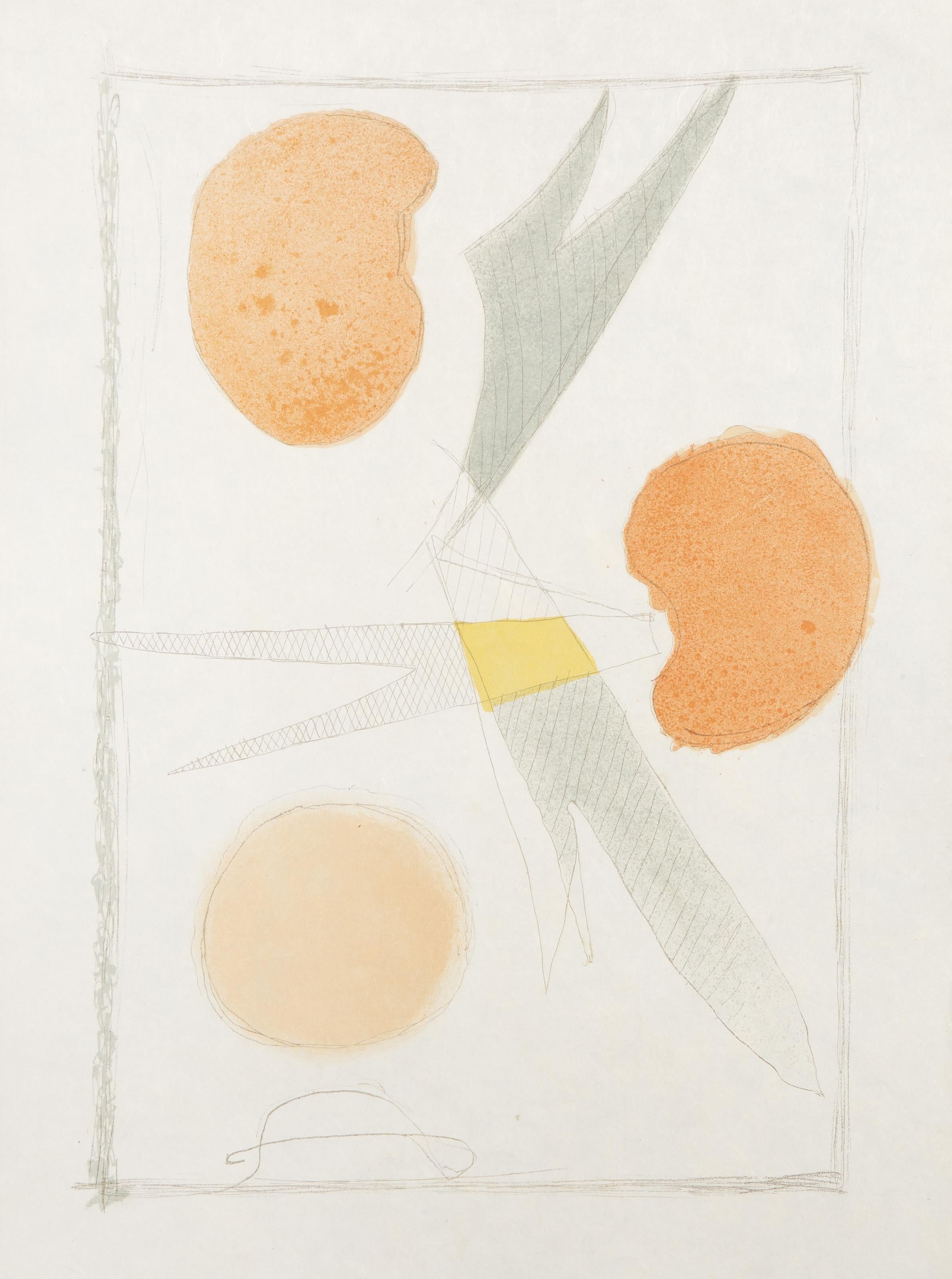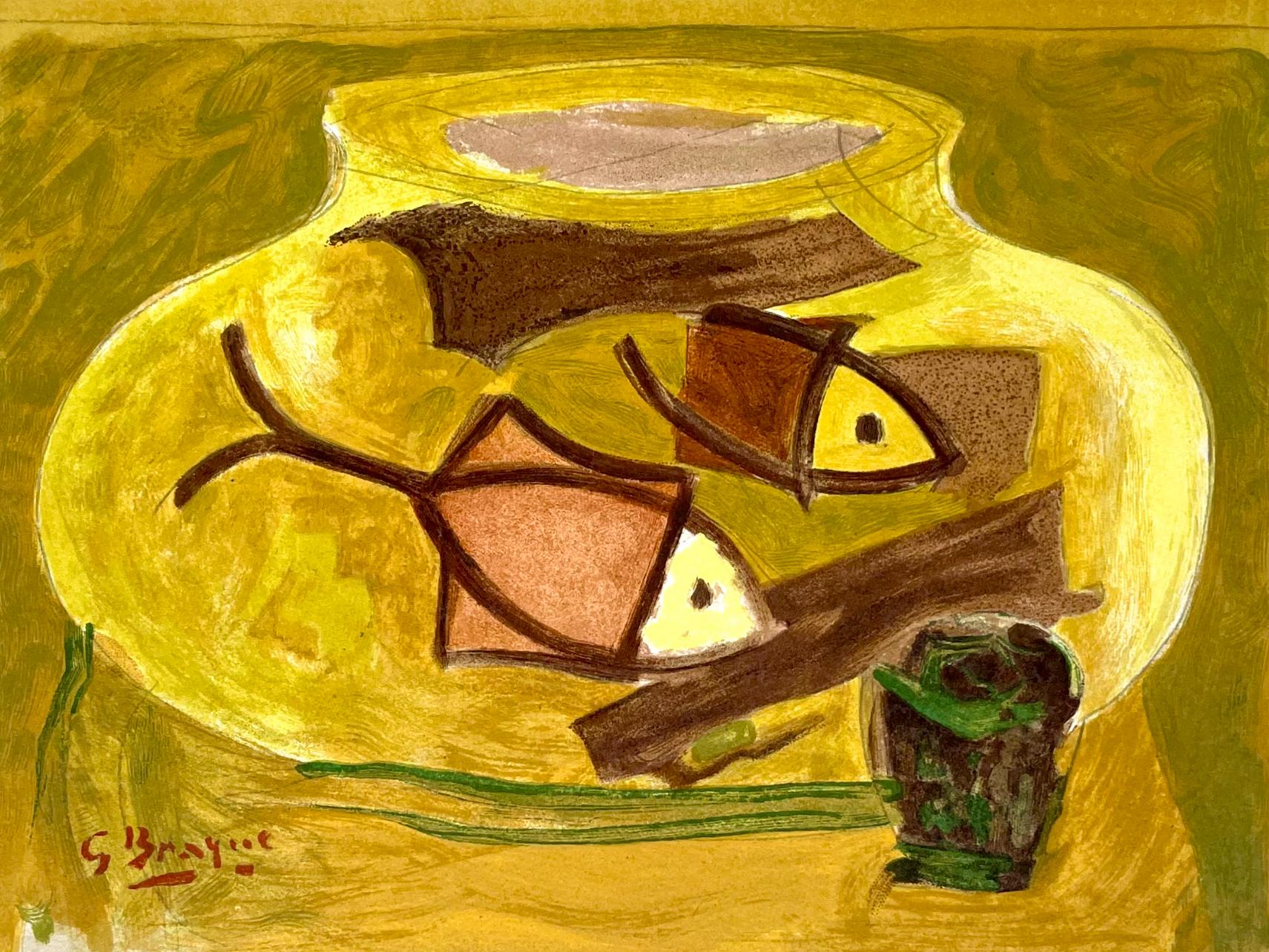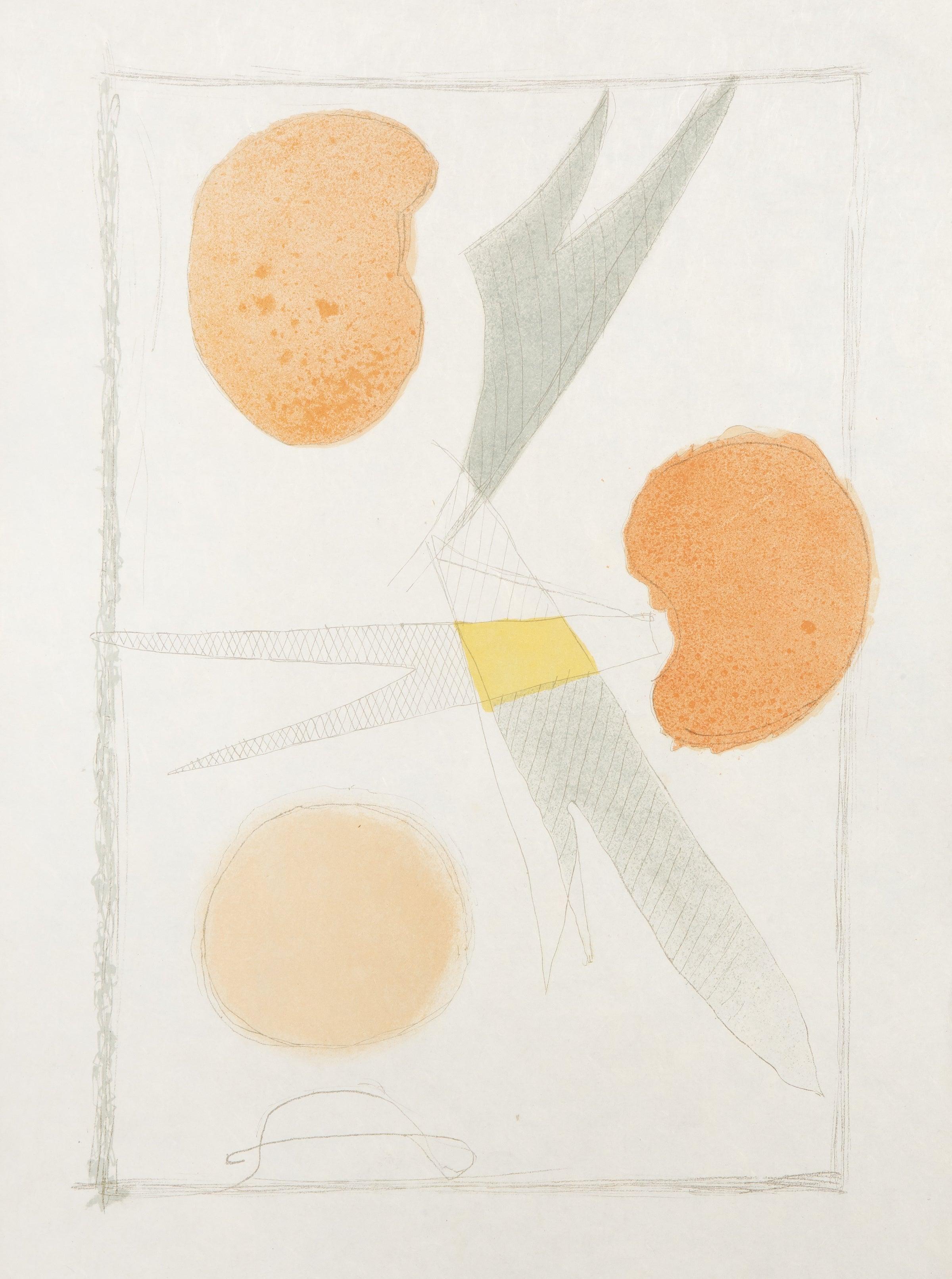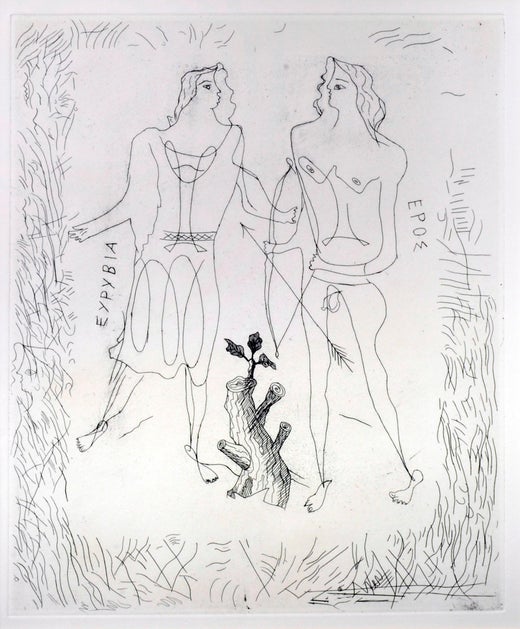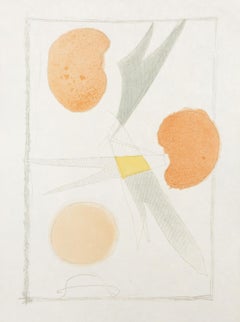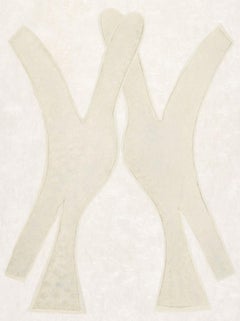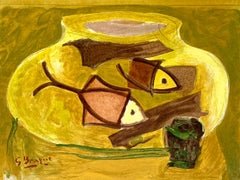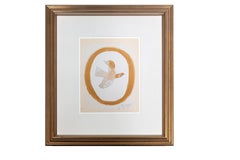Items Similar to Etoile de Mer Rouge (Red Star Fish) from the suite, Si je mourais La-Bas
Want more images or videos?
Request additional images or videos from the seller
1 of 9
George BraqueEtoile de Mer Rouge (Red Star Fish) from the suite, Si je mourais La-Bas1962
1962
$7,000
£5,330.50
€6,087.09
CA$9,835.86
A$10,791.82
CHF 5,684.61
MX$128,380.05
NOK 72,819.18
SEK 66,493.86
DKK 45,476.39
About the Item
This artwork titled " Etoile de Mer Rouge (Red Star Fish)" From the suite "Si je Mourais la Bas" is a rare original color woodcut on L.B hand made paper by renown French artist Georges Braque, 1882-1963. It is hand signed and inscribed H.C (Hors Commerce) in pencil by the artist. The wood block mark is 9.75 x 9.65 inches, sheet size is 18.5 x 14.25 inches, framed is 30.25 x 25.25 inches. Published by Louis Broder, Paris, printed by Fequet and Baudier, Paris. Referenced and pictured in the artist's catalogue raisonne by Dora Vallier, plate #181 page 247. Custom framed in a wooden gold frame, with fabric matting and double gold and color spacer. It is in excellent condition.
About the artwork:
The timely Si je mourais là-bas [If I was to die over there] was published in 1962, a year before Braque died. The suite of eighteen wood-engravings illustrate selected poems from Guillaume Apollinaire Poèmes à Lou, that Braque chose and edited himself. Apollinaire and Braque were close friends and the poet had publicized the work of Braque and his fellow Cubists in his writings on art, before his death in 1918. Despite their friendship, Braque did not agree with his friend's approach and understanding of painting and their disagreements were a source of playful tension between the two. Braque's mysterious images for this suite illustrate this tension.
About the artist:
Georges Braque was born on May 13, 1882, in Argenteuil-sur-Seine, France, a locale favored by many Impressionists painters. He received his first lessons in painting from his father, who was a house decorator and amateur painter. In 1890 the family moved to Le Havre, where Braque would attend evening classes at the Ecole des Beaux-Arts from about 1897 to 1899. At the age of 19, he left for Paris to get his craftsman certificate.
From 1902 to 1904, Braque painted at the Académie Humbert in Paris, where he met Marie Laurencin and Francis Picabia. By 1906, Braque's work was no longer Impressionist and had evolved into the bolder Fauvist style. He showed his Fauve works the following year in the Salon des Indépendants in Paris. His first solo show was at Daniel-Henri Kahnweiler's gallery in 1908.
From 1909, Pablo Picasso and Braque worked together in developing Cubism and by 1911, their styles were extremely similar. One of Picasso's many pet names for Braque was 'Vilbour' or 'Wilbourg', a reference to Wilbur Wright. Picasso saw in their 1908-1914 creative partnership something that was akin to the pairing of brothers Wilbur and Orville Wright, the pioneers of sustained powered flight. In 1912, they started to incorporate collage elements into their paintings and to experiment with the papier collé (pasted paper) technique with Braque utilizing a roll of wallpaper he found in a local shop.
Braque served with honor in the French army during World War I and was seriously wounded in the head, leaving him temporarily blinded and unable to paint. Upon his recovery in 1917, he began a close friendship with painter Juan Gris.
After World War I, Braque's work became freer and less schematic. His fame grew in 1922 as a result of an exhibition at the Salon d'Automne in Paris. In the mid-1920s, Braque designed the decor for two Sergei Diaghilev ballets. By the end of the decade, he had returned to a more realistic interpretation of nature, although certain aspects of Cubism always remained present in his work. In 1931, Braque made his first engraved plasters and began to portray mythological subjects. His first important retrospective took place in 1933 at the Kunsthalle Basel. He won First Prize at the Carnegie International, Pittsburgh, in 1937.
During World War II, Braque remained in Paris. His paintings at that time, primarily still lifes and interiors, became more somber. From the late 1940s Braque also created lithographs, engravings, and sculpture where he utilized his recurring themes of birds, ateliers, landscapes, and seascapes. His international fame continued to grow, when in 1948 he was awarded the main prize for painting at the Venice Biennale, and in 1951, was made a Commander of the Legion of Honour. A few years later, Braques' skill as a craftsman came into play when he designed stained-glass windows for the church of Varengeville and painted the ceiling for the Etruscan Gallery at The Louvre. Georges Braque had the distinction of being the first living artist to have his artworks exhibited at The Louvre in 1961.
During the last few years of his life, Braque's ill health prevented him from undertaking further large-scale commissions, but he continued to paint, create lithographs, and design jewelry. He died on August 31, 1963, in Paris with his wife, Marcelle, at his side.
The work of Georges Braque is held in numerous museums worldwide, including:
:
Guggenheim Museum, New York, NY
Louvre Museum, Paris
Metropolitan Museum of Art, New York, NY
Musee d'Orsay, Paris
Museum of Fine Arts, Boston, MA
Museum of Modern Art, New York, NY
Norton Simon Museum, Pasadena, CA
Tate Gallery, London
- Creator:George Braque (1882 - 1963, French)
- Creation Year:1962
- Dimensions:Height: 30.25 in (76.84 cm)Width: 25.25 in (64.14 cm)Depth: 2.25 in (5.72 cm)
- Medium:
- Movement & Style:
- Period:
- Condition:
- Gallery Location:San Francisco, CA
- Reference Number:Seller: bra/eto/mer/011stDibs: LU66635719972
George Braque
Georges Braque was born on May 13, 1882, in Argenteuil-sur-Seine, France. Braque grew up in the town of Le Havre, and studied evenings at the Ecole des Beaux-Arts there from about 1897 to 1899. Braque left for Paris to study under a master decorator to receive his craftsman certificate in 1901. From 1902 to 1904, Braque painted at the Académie Humbert in Paris, where he met Marie Laurencin and Francis Picabia. By 1906, Braque's work was no longer Impressionist but Fauve in style. After spending the summer of that year in Antwerp with Othon Friesz, he showed his Fauve in the 1907 Salon des Indépendants in Paris. His first solo show was at Daniel-Henri Kahnweiler's gallery in 1908. From 1909 forward, Braque collaborated with Pablo Picasso in developing Cubism, and by 1911, their styles had become extremely similar. In 1912, they started to incorporate collage elements into their paintings and to experiment with the papier collé (pasted paper) technique. Their collaboration lasted until 1914. Braque served in the French army during World War I and was wounded in battle. Upon recovering, he developed a close friendship with the artist Juan Gris. After World War I, Braque's work became less and less schematic and more free. His fame grew in 1922 as a result of an exhibition at the Salon d'Automne in Paris. In the mid-1920s, Braque designed the decor for two Sergei Diaghilev ballets. By the end of the decade, he had returned to a more realistic interpretation of nature, although Cubist elements always remained present in his work. In 1931, Braque made his first engraved plasters and began to portray mythological subjects. His first important retrospective took place in 1933 at the Kunsthalle Basel. In 1937 he won First Prize at the Carnegie International in Pittsburgh. During World War II, Braque remained in Paris. His paintings at that time, primarily still lifes and interiors, became more somber. In addition to paintings, Braque also made lithographs, engravings, and sculpture. From the late 1940s, he treated various recurring themes, such as birds, ateliers, landscapes, and seascapes. In 1954, he designed stained-glass windows for the Varengeville Church. During the last few years of his life, Braque's ill health prevented him from undertaking further large-scale commissions, but he continued to paint, print lithographs, and design jewelry. He died on August 31, 1963, in Paris.
About the Seller
5.0
Platinum Seller
Premium sellers with a 4.7+ rating and 24-hour response times
Established in 1999
1stDibs seller since 2017
872 sales on 1stDibs
Typical response time: <1 hour
- ShippingRetrieving quote...Shipping from: San Francisco, CA
- Return Policy
More From This Seller
View AllLettera Amorosa
By George Braque
Located in San Francisco, CA
This artwork titled "Lettera Amorosa" 1963, is an original color lithograph on Japan nacre paper by renown French artist Georges Braque, 1882-1963. It is hand signed and numbered 42/...
Category
Mid-20th Century Cubist Abstract Prints
Materials
Lithograph
"Tierra Roja" from the "Mexican suite"
By David Alfaro Siqueiros
Located in San Francisco, CA
This artwork titled "Tierra Roja" from "The Mexican Suite" is an original colors lithograph on Arches paper by renown Mexican artist David Alfaro Siqueiros...
Category
Mid-20th Century Modern Landscape Prints
Materials
Lithograph
Son Abrines
By Joan Miró
Located in San Francisco, CA
"Son Abrines" Original etching with aquatint printed on Guarro paper. Ink stamp signed, numbered 23/75 in pencil. Also hand signed in pencil on the back by the grand son of the artis...
Category
1980s Abstract Abstract Prints
Materials
Aquatint
Mythologia Moderna II
By Man Ray
Located in San Francisco, CA
Artist: Man Ray (American, 1890-1976)
Title: Mythologia Moderna II
Year: 1969
Medium: Color lithograph
Edition: numbered 46/175 in pencil
Paper: Arches watermarked
Image siz...
Category
Mid-20th Century Dada Abstract Prints
Materials
Lithograph
Les Nuits de Saint Jean De Luz
By Man Ray
Located in San Francisco, CA
Artist: Man Ray (American, 1890-1976)
Title: Les Nuits De aint Jean De Luz
Year: 1968
Medium: Color Lithograph
Edition: Numbered 87/120 in pen...
Category
1960s Dada Figurative Prints
Materials
Lithograph
Kimi Fuji
By Johnny Friedlaender
Located in San Francisco, CA
This artwork titled "Kimi Fuji" c.1975 in an original color aquatint by noted Polish artist Johnny Friedlaender, 1912-1992. It is hand signed in pencil by the artist. The image (plat...
Category
Late 20th Century Abstract Abstract Prints
Materials
Aquatint
You May Also Like
La Liberte des Mers, Modern Abstract Lithograph by Georges Braque
By Georges Braque
Located in Long Island City, NY
Georges Braque, French (1882 - 1963) - La Liberte des Mers, Year: 1959, Medium: Lithograph on Japon Nacre, Edition: 250, Image Size: 17.5 x 11.5 inches, Size: 22 x 15 in. (55.88 x 3...
Category
1950s Modern Prints and Multiples
Materials
Lithograph
Composition (Vallier 143), La Liberté des Mers, Georges Braque
By Georges Braque
Located in Southampton, NY
Lithograph on grand vélin d'Arches paper. Inscription: unsigned and unnumbered, as issued. Good condition. Notes: from the folio, La Liberté des Mers, 1959. Published by Maeght Édite...
Category
1950s Modern Landscape Prints
Materials
Lithograph
$6,396 Sale Price
20% Off
Free Shipping
Les poissons rouges, Une Aventure méthodique, Georges Braque
By Georges Braque
Located in Southampton, NY
Lithograph on vélin d'Arches paper. Inscription: Unsigned and unnumbered. Good condition. Notes: From the folio, Une Aventure méthodique, 1950; published by Fernand Mourlot, Paris, a...
Category
1950s Modern Abstract Prints
Materials
Lithograph
$5,196 Sale Price
20% Off
Free Shipping
"L'oiseau de sables (Bird of the Sands)" contemporary animal bright signed
By Georges Braque
Located in Milwaukee, WI
"L'oiseau de sables" ("Bird of the Sands") is an original signed lithograph by Georges Braque executed in 1962. It is 37 of an edition of 125. The work is one of five lithographs cre...
Category
1960s Fauvist Animal Prints
Materials
Printer's Ink, Lithograph
Composition (Vallier 143), La Liberté des Mers, Georges Braque
By Georges Braque
Located in Southampton, NY
Lithograph on grand vélin d'Arches paper. Inscription: unsigned and unnumbered, as issued. Good condition. Notes: from the folio, La Liberté des Mers, 1959. Published by Maeght Édite...
Category
1950s Modern Landscape Prints
Materials
Lithograph
$6,396 Sale Price
20% Off
Free Shipping
Derniers Messages, Cubist Lithograph by Georges Braque
By Georges Braque
Located in Long Island City, NY
Georges Braque, French (1882 - 1963) - Derniers Messages, Year: circa 1965, Medium: Lithograph, Image Size: 23.5 x 17 inches, Frame Size: 28 x 19.5 inches
Category
1960s Cubist Animal Prints
Materials
Lithograph
More Ways To Browse
Salvador Dali The Alchemist
Sam Calder
Sam Francis Swatch
Savoy Damien Hirst
Scott Kilgour
Seated Woman Picasso
Shigeo Fukuda
Siri Rathsman
Ski Lift Chair
Skid Row Robert Indiana
Sol Lewitt Poster
Sonia Delaunay Set Of 6 Plates
Stan Solomon
Steve Shaw
Susan Branch
Susan Fiori
Tamayo Watermelon
Temptation Of St Anthony Dali Print
